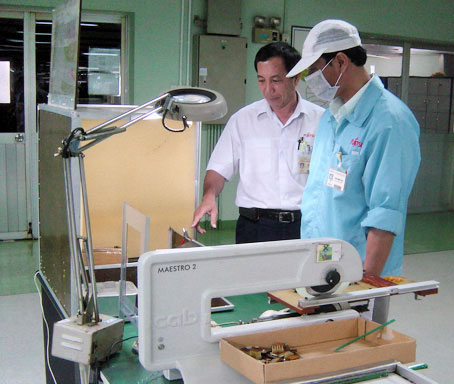
With 558 supporting industry enterprises, Dong Nai is the country’s leading locality in the number of enterprises active in supporting industries. However, they mostly supply crude products, while components, spare parts and advanced materials must be imported, said the Dong Nai Department of Industry and Trade.
 |
| Dong Nai is the country’s leading locality in the number of enterprises active in supporting industries. However, they mostly supply crude products, while components, spare parts and advanced materials must be imported, |
Foreign investors want to buy materials from Vietnamese suppliers if quality, quantity and delivery time are guaranteed, but at the moment they are forced to import the vast majority of goods, said Takanori Yamashita, general director of Fujitsu Vietnam.
Since its factory in the Dong Nai-based Bien Hoa 2 Industrial Park started operation 16 years ago, Fujitsu has been looking for local material suppliers that can satisfy its requirements.
“So far, no local supplier has met our requirements, meaning Vietnam’s supporting industries for electronics manufacturing are still underdeveloped. Can anyone here tell me why supporting industries are underdeveloped in Vietnam?” Yamashita said at the recent seminar on supporting industries in Dong Nai.
He said: “For the development of the Vietnamese economy, your country needs to reorganize the industrial system so that we can buy goods and materials in Vietnam and develop production in Vietnam. Now, we have to import almost everything.”
With 558 supporting industry enterprises, Dong Nai is the country’s leading locality in the number of enterprises active in supporting industries. However, they mostly supply crude products, while components, spare parts and advanced materials must be imported, said the Dong Nai Department of Industry and Trade.
Tran Van Tuan Anh, production manager of Vikyno & Vinappro, a farm machinery producer, said the State should clearly identify the priority sectors whose supporting industries need to be developed, in order to avoid dispersion of resources and spearhead supporting industry products to join the global value chain.
Anh noted the market of semi-finished products and parts for agricultural machinery assembly in Vietnam is a lucrative pie to foreign producers, especially those from China. If inspection is neglected, poor-quality mechanical products will penetrate Vietnam, inhibiting the development of supporting industries for mechanical manufacturing.
Inadequate policies
In July 2007, the Ministry of Industry, now known as the Ministry of Industry and Trade, issued Decision 34/QD-BCN on the development planning for supporting industries until 2010, with a vision to 2020. Later in February 2011, the Prime Minister released Decision 12/2011/QD-TTg shaping the policy for development of certain supporting industries.
However, this year the Ministry of Industry and Trade will release a new plan for supporting industries since the one issued in 2007 has become outdated, said Truong Thi Chi Binh, director of the Center for Development of Enterprises in Supporting Industries under the trade ministry’s Research Institute for Industrial Strategies and Policies.
As for the Prime Minister’s Decision 12, Bo Ngoc Thu, director of the Dong Nai Department of Planning and Investment, said it does not help because the content is too general.
Despite the significant changes in macro policies recently, supporting industry enterprises still find the aforesaid policies out of touch, said Binh.
In Vietnam, supporting industries for motorcycle manufacturing gain the biggest success. Thanks to good consumption in the domestic market, the presence of assemblers like Honda has lured component suppliers to come to Vietnam to set up shop with no need for any supporting policy from the Government.
In fact, supporting industries for motorbike manufacturing had developed before the State planning, decision and supporting policy were released.
When the market capacity is strong enough, supporting industries will definitely grow. For instance, the localization rate of the motorcycle sector has reached over 95%, with 500 enterprises nationwide, supplying components and parts to Japanese motorbike makers.
On the contrary, when the market is too small, it will be hard to develop supporting industries. Toyota Vietnam, for example, has 13 component suppliers for locally-assembled cars, but only has two domestic firms producing auto body repair parts.
At least 30,000 components and spare parts are needed to produce a complete car, but only 50 enterprises are supplying auto parts and components in Vietnam, not enough to meet the demand of 11 auto joint-ventures and over 40 auto assemblers in the domestic market, said the Center for Development of Enterprises in Supporting Industries.
(Source: SGT)





